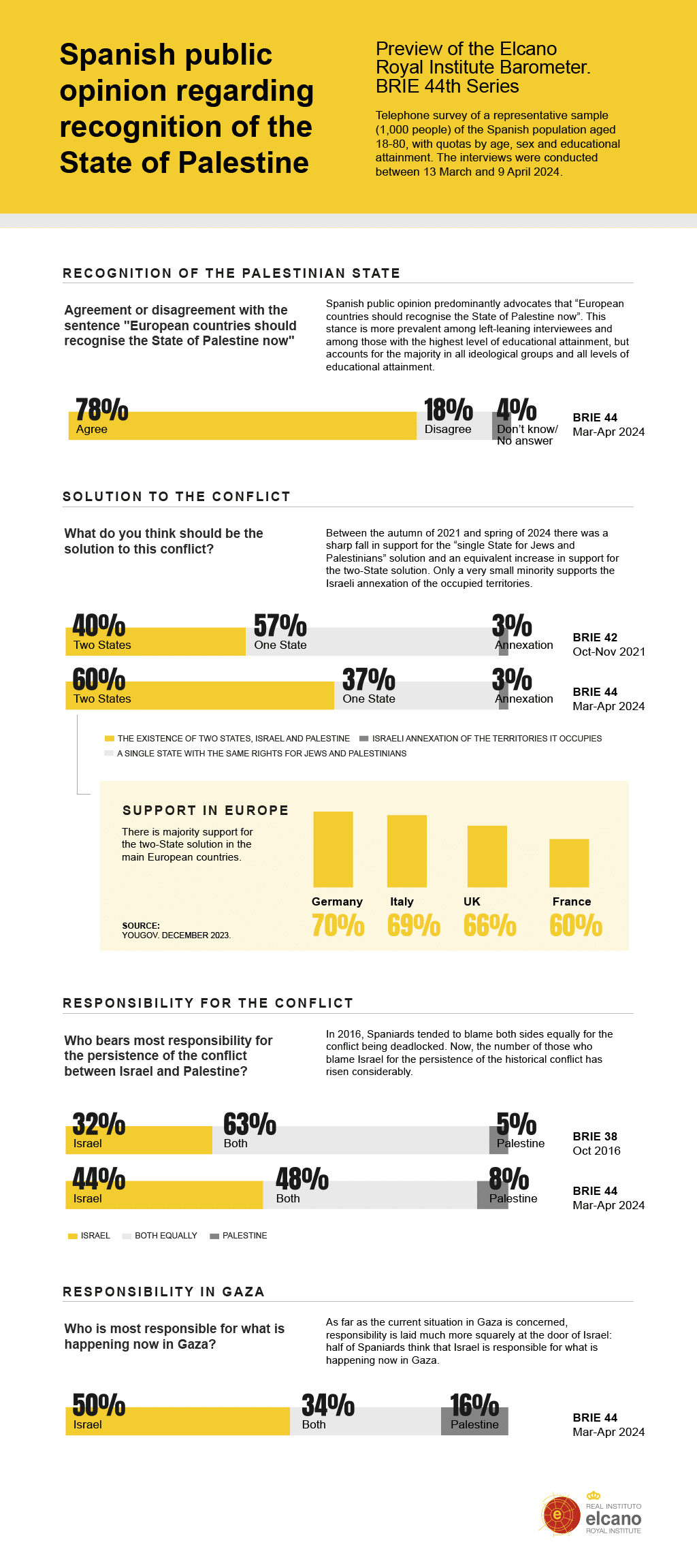This Commentary analyses responses drawn from the 2024 Elcano Royal Institute Barometer (BRIE) in relation to the Israeli-Palestinian conflict. The questionnaire also addressed many other subjects, but here we will focus only on the results relating to this conflict.
The findings show that Spanish public opinion mainly considers (60%) that the solution to the enduring conflict between Israel and Palestine requires the existence of two separate States, while an overwhelming majority (78%) favour the swift recognition of a Palestinian State.

Analysis
Spanish public opinion has a nuanced perspective on the conflict between Israel and Palestine and is capable of distinguishing between this very prolonged conflict and the current situation in Gaza. Almost half the population, 48%, believe that both parties bear the same responsibility for the persistence of the conflict, but only 34% think the same in relation to the current situation in Gaza. In the latter case, responsibility is laid much more squarely at the door of Israel: 50% believe that Israel is responsible for what is now happening in Gaza.
With regard to the general conflict, started more than 70 years ago, in 2016 Spaniards tended to blame both sides equally (63%), while a third identified Israel as being mainly responsible. Now, in the wake of the current war, the number blaming Israel for the persistence of the historical conflict has grown substantially, although they are still outnumbered by those who apportion blame equally.
At any event, then as now, only a small minority believe that Palestine (the Palestinian people) is chiefly responsible for the persistence of the conflict. Those who think that Palestine is chiefly responsible for the current situation in Gaza (16%) are also in a minority, albeit a larger one.
There is a very clear relationship between educational attainment, ideology and the attribution of responsibility in both questions, whether referring to the historical conflict or the current situation. In both cases, the blaming of Israel increases with educational level and with leftward movement along the ideological spectrum. Only among people located on the right (positions 10, 9, 8 and 7 on the 0-10 scale) is there a large percentage, 38%, of individuals who chiefly blame Palestine for the current situation in Gaza. Among the ideologically central population (positions 4, 5 and 6), which accounts for the largest group of the sample, opinions are divided equally between those who blame Israel for what is happening in Gaza and those who blame both sides equally.
As well as blaming Israel more, another notable change in Spanish public opinion is the sharp drop in support for the ‘single State for Jews and Palestinians’ solution (BRIE 2021) and the corresponding increase in support for the two-State solution. Only a small minority (3%) support an Israeli annexation of the occupied territories.
Men, older people, those with a higher level of educational attainment and those who situate themselves on the left give most support to the two-State solution.
As far as the current situation in Gaza is concerned, a large majority (78%) of the interviewees favour the immediate recognition of the Palestinian State by the European nations. This position is even firmer amongst left-wing interviewees and those of a higher level of education, but it is the majority view among all ideological groups and at all levels of educational attainment.
Technical details
- Universe: individuals residing in Spain’s 17 Autonomous Communities and Cities, aged 18-80.
- Sampling: stratified by Autonomous Community and size of municipality, with quotas for educational attainment, sex and age proportional to the distribution in the population.
- Sample size: 1,000 interviews.
- Type of interview: telephone interviews, involving both landlines and mobiles.
- Sampling error: for the global data, with a confidence level of 95.5% and in the worst-case hypothesis of +/-3.2%.
- Fieldwork and data compilation: random strategy.
- Dates of fieldwork: 13 March-9 April 2024.




